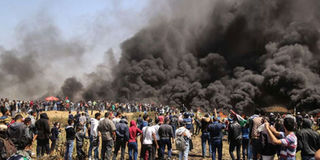Gaza-Israel border: A week of deadly clashes

Palestinian protestors burn tyres during clashes with Israeli security forces on the Gaza-Israel border following a protest calling for the right to return, east of Gaza City on April 6, 2018. PHOTO | MAHMUD HAMS | AFP
GAZA CITY
The Gaza border with Israel has been enflamed by violence since Israeli forces opened fire on a protest march on March 30.
It was the deadliest single day in the territory since a 2014 war with Israel, and led to new riots, clashes and deaths.
Here is a rundown of the unrest:
Bloodiest day in years
On March 30, tens of thousands of Palestinians including women and children gather at sites throughout the blockaded Gaza Strip, which is flanked by Israel along its eastern and northern borders.
They are taking part in "The Great March of Return" which calls for the "right to return" of the descendants of some 700,000 Palestinians who fled or were expelled from their lands during the war over Israel's creation in 1948.
A smaller number stray from the main protest and approach the heavily fortified border fence, confronting Israeli troops by throwing stones and firebombs.
Israeli soldiers open fire, killing 19 Palestinians in what is the bloodiest single day in Gaza since 2014.
The next day, Palestinian president Mahmud Abbas declares a day of national mourning and says he holds Israel fully responsible for the deaths.
Palestinians and Turkey accuse Israel of using "disproportionate force". The Arab League, Egypt and Jordan all condemn the Israeli response.
Officially organised by civilians, the march is supported by Hamas, the Islamist movement that runs the Gaza Strip.
Netanyahu praises soldiers
Thousands of Gazans gather to bury their dead on March 31 while just a few hundred protesters return to several areas near the border to continue the demonstration.
Israeli Prime Minister Benjamin Netanyahu praises troops for "guarding the country's borders".
"Well done to our soldiers," he writes in a statement.
The United States blocks a draft United Nations Security Council statement urging restraint and calling for an investigation of the deadly clashes.
On April 1, Israeli Defence Minister Avigdor Lieberman rejects any independent investigation.
"There will be no such thing here. We shall not cooperate with any commission of inquiry," he tells public radio.
Israel stands firm
The defence minister warns on April 3 that protesters who approach the fence between Gaza and Israel will put "their life in danger".
There is the first death since the 19 were killed, that of a Palestinian shot in the chest by Israeli forces.
On April 5, another Palestinian is killed, this time in an Israeli air strike, the health ministry says.
US President Donald Trump's envoy Jason Greenblatt puts the onus for the violence squarely on the Palestinians. Protesters "should not approach the border fence in any way or any location", he says.
As tensions mount ahead of new Friday protests, marking a week since the first outbreak of violence, defence minister Lieberman says there will be no change in the open-fire rules.
"If there are provocations, there will be a reaction of the harshest kind like last week," Lieberman tells public radio.
The UN envoy for the Middle East peace process, Nickolay Mladenov, calls for peaceful demonstrations and restraint by Israeli forces.
New Friday clashes
On April 6, a week since the violence broke out, thousands of Palestinians gather again near the security barrier.
They burn mounds of tyres and throw stones at Israeli soldiers over the border fence.
The security forces respond with tear gas and live fire, that leaves at least nine people dead, including journalist Yasser Murtaja.
Some 500 people are reported injured by Israeli gunfire including five other journalists.
Kuwait again makes a push at the UN for a statement demanding an investigation into the killings but the US says it is opposed.
Israel's army insists its troops opened fire "in accordance with the rules of engagement".




